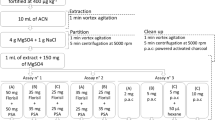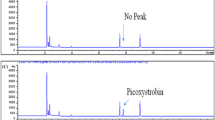Abstract
This study aimed to optimize and validate an analytical method for extraction, detection, and quantification of haloxyfop-methyl, procymidone, and linuron pesticides in carrot samples using solid–liquid extraction methods and low temperature partition (SLE-LTP), accompanied by gas chromatography coupled to mass spectrometry (GC-MS). For SLE-LTP technical optimization, we utilized a complete factorial planning, which had as its variables, agitation time, freezing time, and the correct sample mass/extracting solution volume ratio. The organic extract obtained was analyzed by GC-MS. To test the performance of this procedure, the method was validated and applied to the monitoring of pesticide residues in 20 samples of carrot produced in Alto Paranaíba, Minas Gerais, Brazil. The proposed method showed linearity between 0.5 and 3.5 mg·kg−1 with correlation coefficients greater than 0.99. The quantification limits were 0.48 mg·kg−1 for haloxyfop-methyl, 0.69 mg·kg−1 for linuron, and 0.65 mg·kg−1 for procymidone, values below the maximum residue limit provided by international legislation of 1.0 mg·kg−1 for linuron and procymidone. The use of haloxyfop-methyl is not approved in the cultivation of carrot. The recovery percentages were between 90 and 110 %, with a coefficient of variation of less than 12 %. Ten percent of the carrot samples monitored showed residues of linuron and procymidone in concentrations exceeding those permitted by Brazilian law.


Similar content being viewed by others
References
Abad FC, Winck PR, Benvenutti EV, Peralba MCR, Caramão EB (2007) p-Nitro-N-propylaniline/silica: synthesis, characterization, and its application in matrix solid phase dispersion for multiresidue analysis of pesticides in carrots. J Sep Sci 30:2109–2116. doi:10.1002/jssc.200700065
Abad FC, Winck PR, Silva JM, Caramão EB, Zini CA (2010) Multiresidue determination of pesticides in carrots using pressurized liquid extraction and gas chromatography with mass spectrometry detector. J Braz Chem Soc 21:461–468. doi:10.1590/S0103-50532010000300010
Agüerra A (2002) Multiresidue method for the analysis of multiclass pesticides in agricultural products by gas chromatography-tandem mass spectrometry. Analyst 1:347–354. doi:10.1039/B109499H
Anastassiades M, Lehotay SJ (2003) Fast and easy multiresidue method employing acetonitrile extraction/partitioning and “dispersive solid-phase extraction” for the determination of pesticide residues in produce. J AOAC Int 86:412–431
Bakore N, John PJ, Bhatnagar P (2003) Organochlorine pesticide residues in wheat and drinking water samples from Jaipur, Rajasthan, Índia. Environ Monit Assess 98:381–389. doi:10.1023/B:EMAS.0000038197.76047.83
BRASIL. Agência Nacional de Vigilância Sanitária - ANVISA. Programa de Análise de Resíduos de Agrotóxicos em Alimentos (PARA) (2010) Relatório de atividades de 2009. ANVISA, Brasília
BRASIL. Ministério da Agricultura Pecuária e Abastecimento (2011) Manual de garantia da qualidade analítica. MAPA/ACS, Brasília
BRASIL. Ministério da Agricultura, Pecuária e Abastecimento—MAPA (2012) IN n° 27, de 11 de dezembro de 2012. Tabela de agrotóxicos monitorados e limites máximos de resíduos. MAPA, Brasília, n.240
Celeiro M, Lompart M, Lamas JP, Lores M, Garcia-Jares C, Dagnac T (2014) Determination of fungicides in white grape bagasse by pressurized liquid extraction and gas chromatography tandem mass spectrometry. J Chromatogr A 23:18–25. doi:10.1016/j.chroma.2014.03.05
Costa AIG, Queiroz MELR, Neves AAN, Sousa FA, Zambolim L (2015) Determination of pesticides in lettuce using solid–liquid extraction with low temperature partitioning. Food Chem 15:64–71. doi:10.1016/j.foodchem.2015.02.070
Dias NA, Simão V, Merib J, Carasek E (2015) Use of green coating (cork) in solid-phase microextraction for the determination of organochlorine pesticides in water by gas chromatography-electron capture detection. Talanta 134:409–414. doi:10.1016/j.talanta.2014.11.045
EFSA (2015) European Food Safety Authority. the 2013 European Union report on pesticide residues in food. EFSA J 13:1–169. doi:10.2903/j.efsa.2015.4038
European Comission (2007) Method validation and quality control procedures for pesticide residues. Analysis in Food and feed
Freitas RDS, Queiroz MELR, Faroni LRA, Heleno FF, Moura VV (2014) Desenvolvimento do método de extração sólido-líquido com partição em baixa temperatura para determinação de inseticidas em grãos de milho ozonizados. Quim Nov. 37:238–243. doi:10.5935/0100-4042.20140041
Frenich AG, Fernandez MDMM, Moreno LD, Vidal JLM, Lopez-Gutierrez N (2012) Multiresidue pesticide analysis of tuber and root commodities by QuEChERS extraction and ultra-performance liquid chromatography coupled to tandem mass spectrometry. J AOAC Int 95:1319–1330. doi:10.5740/jaoacint.SGE_GarridoFrenich
Giordano A, Richter P, Ahumada I (2011) Determination of pesticides in river water using rotating disk sorptive extraction and gas chromatography–mass spectrometry. Talanta 85:2425–2429. doi:10.1016/j.talanta.2011.07.087
González-Rodríguez RM, Cancho-Grande B, Simal-Gándara J (2011) Decay of fungicide residues during vinification of white grapes harvested after the application of some new active substances against downy mildew. Food Chem 125:549–560. doi:10.1016/j.foodchem.2010.09.047
Granby K, Andersen JH, Christensen HB (2004) Analysis of pesticides in fruit, vegetables and cereals using methanolic extraction and detection by liquid chromatography–tandem mass spectrometry. Anal Chim Acta 520:165–176. doi:10.1016/j.aca.2004.05.088
Heleno FF, Queiroz MELR, Neves AA, Freitas RS, Faroni LRA, Oliveira AF (2014a) Effects of ozone fumigation treatment on the removal of residual difenoconazole from strawberries and on their quality. J Environ Sci Heal B 4:94–101. doi:10.1080/03601234.2014.846736
Heleno FF, Queiroz MELR, Neves AA, Oliveira AF (2014b) Optimization, validation and application of a method for determination of difenoconazole residues in strawberries after multiple applications. Quim Nov. 37:153–157. doi:10.1590/S0100-40422014000100025
ICH – International conference on harmonisation of technical requirements for registration of pharmaceuticals for human use, Q2B (1996) Validation of analytical procedures: methodoloy
Karmakar R, Singh SB, Kulshrestha G (2012) Water based microwave assisted extraction of thiamethoxam residues from vegetables and soil for determination by HPLC. Bull Environ Contam Toxicol 88:119–123. doi:10.1007/s00128-011-0444
Lehotay SJ, Anastassiades M, Majors RE (2010a) The QuEChERS revolution. LC-GC Europ 8:418–429
Lehotay SJ, Kyung AS, Hyeyoung K, Urairat K, Wusheng F, Katerina M, Eunha H, Natchanun L (2010b) Comparison of QuEChERS sample preparation methods for the analysis of pesticide residues in fruits and vegetables. J Chromatogr A 1217:2548–2560. doi:10.1016/j.chroma.2010.01.044
Liang P, Wang J, Liu G, Guan J (2014) Determination of four sulfonylurea herbicides in tea by matrix solid-phase dispersion cleanup followed by dispersive liquid–liquid microextraction. J Sep Sci 37:2380–2387. doi:10.1002/jssc.201400449
Lozowick B, Kaczynski P (2011) Pesticide residues in apples (2005–2010). Arch Environ Prot 37:43–54, PL ISSN 2083–4772
Mastovska K, Lehotay SJ, Hajslova J (2001) Optimization and evaluation of low-pressure gas chromatography–mass spectrometry for the fast analysis of multiple pesticide residues in a food commodity. J Chromatogr A 926:291–308
Morais EHC, Rodrigues AAZ, Queiroz MELR, Neves AA, Morais PHD (2014) Determination of thiamethoxam, triadimenol and deltamethrin in pineapple using SLE-LTP extraction and gas chromatography. Food Control 42:9–17. doi:10.1016/j.foodcont.2014.01.024
Ribani M, Botolli CBG, Collins CH, Jardim ICSF, Melo LFC (2004) Validação em método cromatográfico e eletroforéticos. Quim Nov. 27:771–780. doi:10.1590/S0100-40422004000500017
Sanagi MM, Salleh S, Ibrahim WAW et al (2013) Aboul-Enein. molecularly imprinted polymer solid-phase extraction for the analysis of organophosphorus pesticides in fruit samples. J Food Compos Anal 32:155–161. doi:10.1016/j.jfca.2013.09.001
Shizuka SS, Satoru N, Rieko M (2014) Multiresidue analysis of pesticides in vegetables and fruits by supercritical fluid extraction and liquid chromatography-tandem mass spectrometry. Food Hyg Safe Sci 55:142–151. doi:10.3358/shokueishi.55.142
Sousa DA, Gonçalves RM, Heleno FF, Queiroz MELR, MARCHI MRR (2014) Chemometric optimization of solid–liquid extraction with low-temperature partition (SLE-LTP) for determination of persistent organic pollutants in Caiman yacare eggs. Microchem J 114:266–272. doi:10.1016/j.microc.2014.01.012
Štajnbaher D, Zupancic-Kralj L (2003) Multiresidue method for determination of 90 pesticides in fresh fruits and vegetables using solid-phase extraction and gas chromatography–mass spectrometry. J Chromatogr A 1015:185–198. doi:10.1016/S0021-9673(03)01211-1
USEPA. United States Environmental Protection Agency (2013) Soil screening guidance: user’s guide. Office of Solid Waste and Emergency Response, Washington, DC
Vieira HP, Neves AA, Queiroz MELR (2007) Otimização e validação da técnica de extração líquido-líquido com partição em baixa temperatura (ELL-PBT) para piretróides em água e análise por CG. Quim Nov. 30:535–540. doi:10.1590/S0100-40422007000300006
Funding
No funding exists.
Conflict of Interest
All authors declare that they have no conflict of interest.
Compliance with Ethical Standards
This article does not contain any studies with human participants or animals performed by any of the authors.
Informed Consent
Not applicable.
Author information
Authors and Affiliations
Corresponding author
Rights and permissions
About this article
Cite this article
Araújo, E.A., Lara, M.C.R., dos Reis, M.R. et al. Determination of Haloxyfop-Methyl, Linuron, and Procymidone Pesticides in Carrot Using SLE-LTP Extraction and GC-MS. Food Anal. Methods 9, 1344–1352 (2016). https://doi.org/10.1007/s12161-015-0315-3
Received:
Accepted:
Published:
Issue Date:
DOI: https://doi.org/10.1007/s12161-015-0315-3




